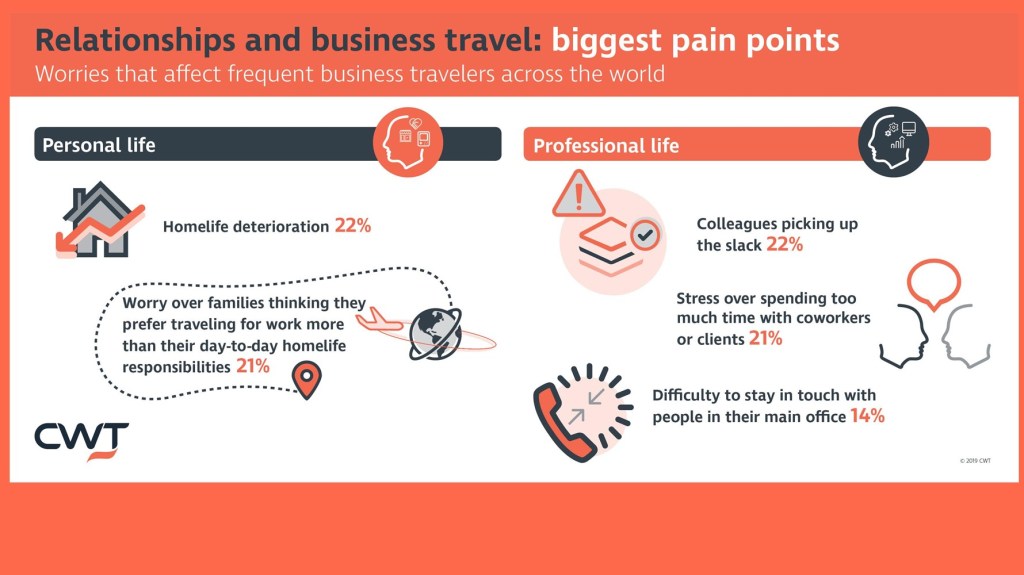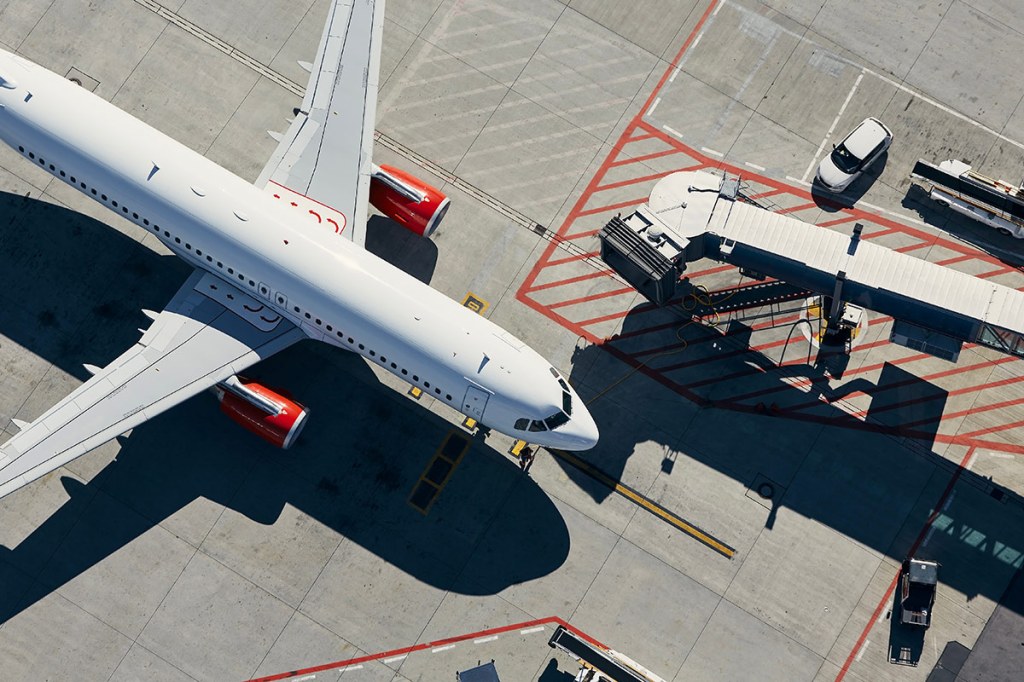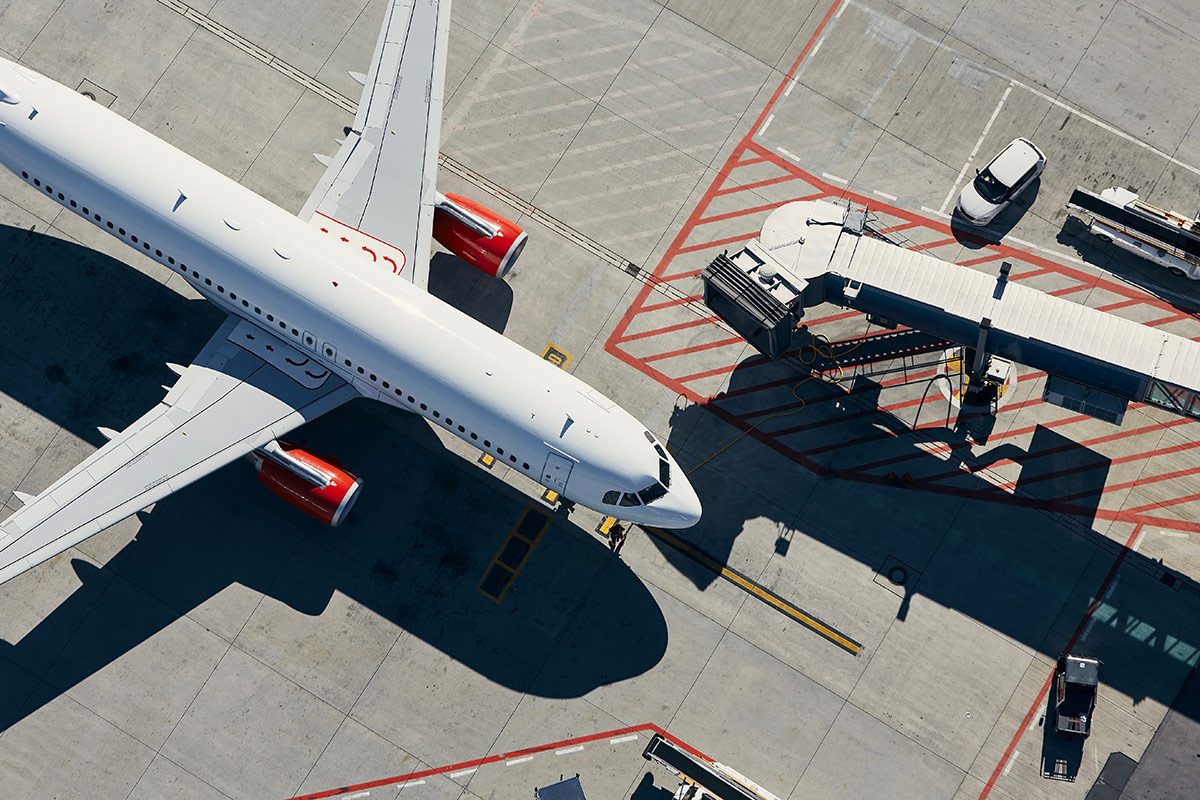Introducing the latest myCWT product and service enhancements
Building on our digital, omnichannel myCWT platform, our new products and services will simplify travel management for you and your employees – anytime, anywhere, anyhow.
Note: Featured services may not be available in your country at this time. Please reach out to your CWT representative for more details.
Hear from Chief Product Officer, Erica Antony as she shares the key product highlights of 2024, along with the key areas driving innovation.
-

2040: Baseline, Boom or Bust
As we enter an era of rapid transformation and unprecedented challenges, it is essential for travel managers, meeting & event planners, and corporate decision-makers to look ahead and frame our current strategic thinking with a clear vision of the future. Business travel and meetings and events (M&E) are poised for significant change over the next decade and a half, driven by a complex interplay of sustainability goals, technological advancements, evolving work models, and geopolitical dynamics.
In this paper to mark the 10th anniversary of our Global Business Travel Forecast, we explore, for the first time, a long-term vision of the future and potential trajectories through three distinct scenarios, each offering insights into how these forces should affect policy-making, budgeting and priorities. By examining these scenarios, we can better understand the diverse possibilities that lie ahead and the strategic imperatives required to thrive in each potential future.
Based on trajectory data analysis and interviews with industry leaders, behaviorists and climate tech founders, this forward-looking approach enables us to anticipate changes, strengthen our strategies, and make informed decisions that align long-term objectives. It is through this lens of foresight and adaptability that we can build resilience, seize opportunities, and navigate the complexities of the future.
We invite you to reflect on the insights presented, and consider how your organization can prepare for the opportunities and challenges that lie ahead. Together we can ensure that travel and meetings remain catalysts for growth, scalability and sustainable practices.
- Scenario development is both an art and a science
- Megatrends Shaping the Future of Business Travel, Meetings and Events
- Sustainability goals the new crux of corporate policy
- Technology Revolutionizes Travel Management
- Modern work models spark new travel patterns
- Changing demographics open doors to new opportunities
- Three Scenarios: Base case, boom and bust
- Future-proofing strategies

-

CWT GBTA Global business travel forecast 2025
When it comes to pricing, global business travel has finally reached an enduring, higher baseline. Prices will continue to rise in 2025, but only moderately, so expect a period of normalized growth.
However, this pricing environment, one of marginal gains and price regularity, is fragile. Global leisure travel has now realized a lot of its pent-up demand, while corporate travel has been resurgent, with 2024 edging at preCovid levels.
There are many factors at play, whether its volatile oil prices, labor costs and constraints, inflationary pressures, and geopolitical factors. As this elevated baseline edges upwards, albeit marginally, travel budgets will come under increased scrutiny, especially as travel patterns and attitudes change.
It’s why business travel can’t be viewed in a silo, and the true value to an organization must be fully realized. This forecast can help with those calculations.

-

Capitalize on emerging technologies in corporate travel
Technological advancements are accelerating at an unprecedented pace. How will emerging innovations like Generative AI, blockchain, and self-sovereign identity (SSI) transform corporate travel?
BTN and CWT probed global CEOs, travel managers, industry consultants and tech experts on the promises, questions, and expectations these innovations raise and how they are set to reshape traveler experience, cost control and service delivery in corporate travel and events.
Download and discover
- The technologies that will have the greatest impact on corporate travel in the next 2-5 years
- How these emerging technologies are poised to control costs, enhance service and security, and boost efficiency
- The critical challenges, opportunities, risks and roadblocks each innovation raises
- What travel managers, buyers and experts anticipate from these innovations

-

Creating a culture of compliance – How communication can shift traveler behavior

The challenge
The nature of the client’s work meant the company consistently had a large amount of travelers on the road. Yet, when the company’s travel manager first started, they struggled to gain support for the travel program, with many travelers incorrectly believing they could find better deals outside of the preferred channels.
Our client knew they needed to increase compliance for multiple reasons. One, people are the company’s greatest asset and ensuring their safety was crucial. Two, an increase in travelers booking in-channel would lower costs and strengthen the company’s negotiating power for further discounted rates.
The solution
The company worked with their CWT Client Executive to instill multiple communications levers to increase awareness.
First, the company selected preferred vendors and shared that information broadly. Employees knew where they were expected to stay and the consistency made it easier to follow policy.
The travel manager also began using Program Messenger to send a “thank you” message to travelers after each new booking made through CWT. The message reinforced positive behavior by highlighting the discounts travelers received, reminding travelers that they can strengthen the company’s negotiating power by booking at preferred properties, and stressing the importance of booking in-channel so the company could locate and assist travelers in an emergency.
In addition, the travel manager invited the company’s hotel partners to host mini roadshows during which they could meet travelers and promote their properties over coffee or breakfast. matches and customer service.
The results
Improved communication and the introduction of Program Messenger contributed to an increase in compliance every year since 2014. Global hotel attachment also increased by 4% from 2016 to 2018. Program Messenger was an effective way to steer a cultural change and remind travelers of the benefits to booking in-policy.

“Program Messenger was an effective way to steer a cultural change.”
For more information, please contact your CWT representative.
The results referred to in this case study are unique to the particular client. Outcomes may vary by company.
-

Home and away: 3 ways to make business travel easier on your family
If you’re part of a couple with one or more dependents – be they human, fur baby or plant- you’ll recognize the irritation that can arise when your partner returns from a work trip after you’ve been at home juggling a job, care duties and planning a dinner you committed to host and now regret.
When our son was four months-old my husband waltzed in from a business trip and made a throwaway comment about the dinner party email I had failed to respond to. The rumblings of irrational fury were frankly concerning.
That’s the thing about business travel. While one partner is at home drinking thrice-microwaved coffee and bathing the baby in-between filing invoices, the traveling partner sips flat whites with a client who praises their work. While one Googles where to take the client for dinner, the other Googles whether or not it is possible to die from three consecutive nights of not sleeping.
In a matter of decades, the portrait of the modern family has changed dramatically. According to the Pew research center that studies social trends, children in American households are more likely than not to grow up in a household in which their parents work, and in nearly half of all two-parent families, both parents work full-time. It’s a trend that’s growing all over the world.
We are juggling more than ever, and frequent travel –with its propensity to throw delicate routines into disarray – is ripe for resentment if not handled with care.
CWT research reveals that 22% of frequent business travelers believe their business travel commitments erode the quality of their relationships and home life. Whilst 21% worry their families think they prefer traveling for work more than their day-to-day home-life responsibilities. Here are three ways to keep things sweet where it matters most.
1. In Good Company – Does your travel policy put your family first?
Ask your company if they work with a TMC that helps them offer an expanded set of options without necessarily adding cost. For example, some offer same-day trips for working or single parents.
“Companies need to be aware of the concerns that business travelers face and help to address them head-on,” says Catherine Maguire-Vielle, CWT’s EVP and Chief Human Resources Officer. “Relationships are a fundamental part of a person’s wellbeing and companies have the obligation to ensure their employees’ travels are not jeopardizing them at home or in the office.”
2. Stake in the future – Your partner is your most important stakeholder
At work, you wouldn’t schedule a call and then cancel it without informing your colleague. You wouldn’t think to embark on a trip without your team knowing how it will benefit them. Yet, we do that to our significant other more readily.
Communication is critical for any relationship, but it doubles in importance when that relationship must stand the test of frequent travel.
If you say “I’ll call you tonight around 6:30pm” keep the promise or send a text to reschedule. Failing to stick to commitments fuels underlying tension. Even set reminders on your phone or calendar.
Equally, let your partner know how your travel benefits your home life. Will it land you a deal that adds to the family finances? Will you learn a new skill that makes you more content and thus a better partner at home?
3. Tech it to the next level – Minimize disruptions to your trip
Subscribe to apps or services that provide up-to-the-minute information about changes to your journey. Some third-party tech providers also provide access to airport lounges once a significant delay is announced, allowing you to finish work on the road and avoid eating into precious family time.
Image credits: Adobe Stock
-

Homelife deterioration and putting pressure on colleagues are the two biggest pain points of business travel
Independent research commissioned by CWT, the B2B4E travel management platform, has revealed the two biggest worries that affect frequent business travelers across the world are homelife deterioration and putting pressure on colleagues.
When it comes to their personal life, 22% believe their business travel commitments erode the quality of their relationships and homelife. Whilst 21% worry their families think they prefer traveling for work more than their day-to-day homelife responsibilities.
On the professional side, 22% feel guilty that their colleagues have to bear the load of their work whilst absent, 21% stress over spending too much time with coworkers or clients, and 14% are concerned about the difficulty of staying in touch with people in their main office.
“Even though the same research reveals that business travelers feel that positives outweigh negatives at work (92%) and at home (82%) when traveling for business, companies need to be aware of the concerns that business travelers face and help to address them head-on,” said Catherine Maguire-Vielle, CWT’s EVP and Chief Human Resources Officer. “Relationships are a fundamental part of a person’s wellbeing and companies have the obligation to ensure their employees’ travels are not jeopardizing them at home or in the office.”
When looking at regional differences amongst frequent business travelers, Americans are in general the biggest worriers versus their European and Asia Pacific counterparts.
26% believe their home and personal relationships suffer versus 23% of Europeans and 18% of Asia Pacific travelers. 23% claim that spending too much time with co-workers or clients on the road can be stressful versus the same percentage of Europeans and 19% of Asia Pacific travelers. 22% are concerned that their families think they enjoy traveling for work more than their day-to-day homelife responsibilities versus 17% of Europeans and 23% of travelers from Asia Pacific.
That said, Americans are less concerned about the difficulty of staying in touch with people in their main office (13% versus 14% of Europeans and Asia Pacific travelers) and coworkers picking up the slack (16% versus 25% of Asia Pacific travelers and 24% of Europeans).

Generational differences
Boomers in Asia Pacific and Europe are more likely to say that home and personal relationships suffer when they travel. However, in the Americas, Gen X travelers take the lead.
The Gen X travelers are also most worried about colleagues picking up the slack. They scored the highest percentage in the three regions.
Millennials score higher than the two other generations in every region when it comes to being concerned about their families believing that they enjoy traveling for work more than their day-to-day home life and responsibilities, and about the difficulty of staying in touch with people in their main office.
When it comes to the stress caused by spending too much time with coworkers or clients on the road, generational differences vary in every region. In Asia Pacific Millennials come first; in the Americas, Boomers and, in Europe, Gen X and Boomers are even.
CWT is a leading global partner in business travel, meetings, and events. Operating across six continents, we deliver sustainable, tailored solutions that help organizations connect, engage, and thrive in an evolving world. Our myCWT platform integrates advanced technology with human expertise to simplify travel and enhance traveler and attendee experiences. Extensive global coverage, seamless data integration, AI-driven analytics, and carbon-conscious travel tools enable businesses to optimize their travel and meetings programs while delivering measurable value.
With 150 years of industry experience and a deep commitment to partnership, CWT collaborates with clients to shape the future of business travel and events, making them more efficient, responsible, and impactful.
-

Lost in Transition: How to manage change in corporate travel programs
Throughout the world, organizations are undergoing seismic shifts in their travel programs as they respond to technological advances, developments in the supply chain and evolving traveler expectations.
India, one the world’s fastest growing economies, is a clear example. Debamitra Banerjee, Director of Strategic and Multinational Sales, India at CWT, says organizations – especially Indian multinationals – are moving toward more structured travel programs, consolidating their suppliers and strengthening their policies to ensure cost efficiencies, meet their duty of care obligations and maximize traveler convenience and productivity. “Travel is very fragmented in India, and organizations could have different partners for airline bookings, for hotels and for ground transportation. But there is a growing focus on moving toward a single structure for their program.”
The maturation of Indian corporate travel includes increased use of self-booking tools, according to Anikesh Patel, CWT’s Director of Customer Management for India, “but we might see mobile apps leapfrog over this technology, provided the tools are available”.
Another unstoppable trend is the growth of the sharing economy. “Sharing economy providers are creating dedicated business travel teams and bespoke services so that they can gain penetration in the corporate market,” he says. “At this stage, most corporates are trying to figure out how to exploit the opportunities presented by the sharing economy – whether that be by wide-scale adoption or just using certain types of services for specific categories of travelers.”
Making the changes real
Bharat Jain, CWT’s Director of Global Supplier Management for India sees travel departments as the main drivers of change in policy areas, and notes that the path is generally easier with technology changes than with migrations from one supplier to another.
Patel observes that organizational culture plays a major role in determining how change is handled among clients. “Some organizations are centralized and autocratic and they can mandate new processes and systems. Others are more traveler-centric and have to use different methods to engage travelers – but overall, they are cautious and seek buy-in, so they don’t move very quickly.”
Patel cites the adoption of Uber as an example of the organizational and cultural minefield which travel managers have to navigate. “I’ve seen organizations where they are only allowing male employees to use Uber. Others restrict the use to certain times of the day. Similarly, with Airbnb, we are not seeing wholesale adoption, but rather limited use for specific staff categories, destinations or stay durations,” he explains.

Market Sharing: The sharing economy can be a cultural and organizational minefield.
Internal resources also influence the speed of adoption, according to Banerjee, who notes significant differences between organizations with dedicated travel teams and those where travel forms part of the broader administrative process. “But we are seeing the increasing development of travel verticals, with a sourcing team and ongoing program management resources.”
“Our focus at CWT is on providing the tools and processes to simplify travel, but also to put the traveler at the center of engagement,” says Patel. This traveler focus plays a key role in ensuring policy adoption and assists with changes. “Travelers are far more open to change when they see the benefits,” he explains.
Change management in action
CWT assisted a large Indian corporation to implement online self-booking. “In the space of a year, they moved from zero online bookings to 40% adoption,” says Patel.
The adoption was assisted through a combination of education and communication.
“We used a range of roadshows and engagement sessions, we shared reports and kept them fully informed every step of the way and they used their internal communications to reinforce the benefits,” he explains. “That engagement and communication kept the ball rolling and helped them through the challenges of change management.”
One Indian information technology service and consulting company that has gone through significant changes, underestimated the communication required to drive change. “Awareness regarding the launch was lower than expected,” explains the company’s head of procurement for global travel and lodging. In retrospect, he would have broadened the communication to reach a larger user group.
The IT multinational, which consolidated its global TMC partners and introduced self-booking technology, attributes the overall success of the travel program update to vigorous user acceptance testing, communication through teasers, Webex and face-to-face meetings with function leads.
Poor communication and a lack of an adequate support system were the most common sources of failure, according to a snap poll of CWT clients. And poor communication was also identified as a major change hurdle between organizations and their suppliers.
The client poll also revealed that committee-based decision-making was the most commonly employed approach to travel program change.

People First: A travel policy should apply to everyone.
10 tips for successful change management
- Know your travelers: Understand how your current program works by seeking feedback from all the stakeholders. It’s important to understand their readiness for change and to pace your efforts accordingly.
- See what others are doing: Use your networks and the insights of partners like travel management companies to gain an understanding of what is possible and how others have adopted new practices and technologies.
- Have a plan: Just as you would need a map to plan a trip, the adoption of a new policy needs to be planned, with detailed steps to guide the process.
- Change takes time: Most organizations underestimate the time and effort required to change travel policies. Rather than rushing in, organizations are advised to look carefully at the resources required to drive change and to set realistic timelines.
- It’s everyone’s business: A travel policy should apply to everyone, including top executives, and the management team should lead by example.
- Identify internal influencers: Organizations can drive change more easily when they identify staff members who can act as catalysts and motivate their peers.
- Carrot or stick: depending on your organizational culture, you may have to mandate the new policy and enforce it or seek the buy-in of all your stakeholders.
- Communication is key: The benefits of any change need to be clearly explained to all stakeholders. This requirement is often overlooked, but unless travelers understand the need for change and the advantages it will bring, they may not embrace the new ways.
- Use your data: Travel is awash with data, but to maximize the benefits, travel departments need to analyze the data with a view to improving processes.
- Don’t ‘set and forget’: The travel environment is dynamic and what works today might not get you through tomorrow. So, it’s important to understand that change is an ongoing process – and travel departments need to
-

RoomIt by CWT further bolsters customer experience and product innovation strategy with two key appointments
RoomIt by CWT, the global hotel distribution division of CWT (the B2B4E travel management platform), announces the appointments of Jeff Zidell as Senior Vice President and Customer Experience Officer, and Ellen Zfaney, as Vice President, Supply Strategy and Innovation.
“Our number one priority today, not just in RoomIt, but across our entire organization, is improving the traveler experience,” said Dave Falter, President, RoomIt by CWT. “We are excited to have Jeff and Ellen on board to build on RoomIt’s goal of delivering customer experience excellence with more relevant content, better rates and amenities, increased availability, loyalty rates, and a simple booking experience. Along with the wider RoomIt leadership team, I am delighted to welcome Jeff and Ellen, who share RoomIt’s belief that transforming your travel program to drive better compliance and results begins with a better customer experience.”
Jeff joins RoomIt via startup CorePoint Lodging, where he was Senior Vice President, Asset Management. Prior to that, he spent nearly a decade with Hyatt Hotels, where he was SVP, Loyalty Marketing and Partnerships.His multi-industry background within highly competitive industries and rapidly evolving markets, position him well to lead RoomIt across all channels (Online Booking Tools, CWT TMC & RoomIt channels), and head up RoomIt’s user experience, marketing and public relations groups. He reports to Dave Falter, President, RoomIt by CWT.

Ellen Zfaney, VP, Supply Strategy and Innovation, RoomIt by CWT
Ellen joins RoomIt from Expedia, where she was Head of Global Strategic Partnerships for over three years. Prior to that, she was Vice President, Americas Partnerships, Orbitz Partner Network (OPN) at Orbitz Worldwide for almost 11 years. Her RoomIt responsibility will see her lead the market management organization and the newly-created sales effectiveness global supply group. Ellen’s focus will be on positioning RoomIt’s hotel strategy and driving innovation in hotel supply channels to drive better customer experience. She will report to Shannon Hyland, Senior Vice President of Global Supply, RoomIt by CWT.
CWT is a leading global partner in business travel, meetings, and events. Operating across six continents, we deliver sustainable, tailored solutions that help organizations connect, engage, and thrive in an evolving world. Our myCWT platform integrates advanced technology with human expertise to simplify travel and enhance traveler and attendee experiences. Extensive global coverage, seamless data integration, AI-driven analytics, and carbon-conscious travel tools enable businesses to optimize their travel and meetings programs while delivering measurable value.
With 150 years of industry experience and a deep commitment to partnership, CWT collaborates with clients to shape the future of business travel and events, making them more efficient, responsible, and impactful.
About RoomIt by CWT
RoomIt by CWT is the hotel distribution division of CWT. Every day we match travelers with the right room at the right rate, and every minute we book over 30 hotel rooms. We also provide travelers with the amenities and loyalty programs they want, while helping organizations control their budget and improve travel oversight. -

Ifs and Bots: Demystifying artificial intelligence and its applications in travel
In recent years, artificial intelligence (AI) has become one of the most talked about trends in corporate travel. But while travel managers are showing increased interest and curiosity in AI, there is still much confusion about what the term actually means and how it can be applied to business travel.
In a survey of travel buyers conducted by Business Travel News (BTN) in 2018, only 16% of respondents said they had “good” or “excellent” knowledge about AI. The majority admitted to having limited awareness about the subject. The same survey also found minimal adoption of AI solutions in corporate travel programs thus far.
What is AI?
“Artificial Intelligence” is a marketing term rather than a single technology suite, according to Dr. Eric Tyree, Chief Data Scientist at CWT. “Broadly speaking, AI is computers doing things that people thought only humans could do, and so that definition evolves over time as computing capabilities become more advanced.”
When English computer pioneer Alan Turing developed his test for AI, he was looking for a machine that behaved in a way that was indistinguishable from a human. The infamous Turing test, which is seen as a hallmark of AI, investigates the ability of a machine to execute tasks such that a person cannot tell if the task is being completed by a human or a machine.
There are various technologies that are talked about as “AI”, with differing methodologies and levels of sophistication used to execute tasks.
Towards the less sophisticated end of the spectrum there is “robotic process automation” (RPA), which uses technology to automate simple tasks. Because processes repeated by a machine are faster and more accurate, RPA can be used to automate tedious and repetitive tasks, allowing people to be more productive. Whether this constitutes ‘true’ artificial intelligence on the part of a machine is a philosophical question, but RPA is undoubtedly a powerful task automation technology.
Then you have “machine learning”, which uses examples to learn the underlying patterns and drivers in data or a task. It improves processes by referencing previous or example interactions. When there is a decision that the technology needs to make, it makes it based on the patterns it has seen and its ability to extrapolate from the patterns to new ones it experiences. For example, the past ten times you called a travel consultant, you booked with airline X. On your eleventh call, even though you do not have this specific information in your profile, machine learning will infer you will most likely be booking airline X. However, if you travel to a new destination not served by airline X, if the training data is rich enough, the machine learning algorithm may correctly infer your preference for airline Z which is similar or is an alliance member with airline X.
More sophisticated machine learning techniques can be even be overlaid on RPA to ‘teach’ machines the more subtle or complex elements of a task, rather than explicitly programming it.
But while RPA and machine learning do enable computers to display some human-like characteristics, there is of course much more to AI.
Really well-implemented AI is the ability for a computer to apply human-like intelligence to a task – or series of tasks – to ensure the best outcome. This is often accomplished by combining process automation, machine learning, expert logic and other techniques to solve problems and complete tasks that previously required human intervention.
The aim here is to use a variety of technologies to give the system the ability to learn and adjust its processes to improve outcomes over time. This enables AI to redefine and re-align processes by developing an understanding of the business at hand. It is able to apply this understanding to a particular process to make decisions, even if it has not undertaken this specific process before. Consider facial recognition as an example. When beginning to recognize faces, an AI-enabled engine might have a low success rate at first. However, with larger, richer data, explicitly logical enhancements and other modifications (both human and computer implemented), it will become more and more accurate, quick and sophisticated in recognizing faces – like learning to ignore glasses, beards and makeup to more accurately recognize the true underlying facial characteristics of people.

How May I Help? There are myriad ways AI can be applied to business travel
How is it being used in travel?
In the travel context, a wide range of AI techniques and technologies are being leveraged to enhance or automate traditionally human-executed tasks, to the point that we are unaware whether it is a human or computer conducting it. Travel AI is starting to pass the Turing test.
“Most AI today is very observational in that it looks at patterns and either tries to see those patterns in data it hasn’t seen before or tries to extrapolate from what it has seen in data in the past,” Dr. Tyree explains. “However, this is changing rapidly with the growing sophistication of AI applications in travel, where ensembles of technologies are being used to create human-like automation of tasks. Coupled with the growing power, increasing speed and decreasing cost of computing, the amount of data available is also growing exponentially, leading to the wider application of AI.”
There are myriad ways that AI could potentially be applied to change the way business travel is viewed, managed and experienced. Here are some of the exciting applications we’re seeing today, and a few that are around the corner:
Facial recognition to speed up airport check-ins
Several airlines and airports around the world are testing and implementing facial recognition software that can verify travelers with a “quick photo capture”, allowing passengers to board using a biometric self-boarding gate. This is expected to improve safety and security, while creating a faster and more efficient check-in and boarding process.
Robot hotel concierges creating a better guest experience
A number of hotels have been experimenting with AI-powered robots to manage guest services. A robot concierge named Connie, developed by IBM, has been deployed at the Hilton McLean in Virginia in the United States. It has been introduced in a pilot program designed to help guests figure out what to visit, where to dine, and how to find things they need. The idea is that it will reduce the need for guests to wait in line to ask a question, while freeing up employees’ time to focus on other tasks.
More relevant booking search results
Just as Amazon and Netflix suggest new products and movies based on your preferences and past selections, AI is being used to show business travelers more relevant search results – while ensuring they remain within their organization’s travel policy, of course. This helps reduce the time they spend searching and booking, allowing them to focus on their work and be more productive.
Quicker support with chatbots and messaging
If you’ve ever opened a chat box when contacting your bank or talking to a retailer online, you’ve likely experienced AI-enabled messaging. This is being applied to business travel too.
CWT is rolling out a hybrid messaging model, which has an AI-powered chatbot supported by an experienced human agent. Travelers can ask for assistance by sending text messages via the mobile app, where CWT’s virtual assistant responds immediately. CWT’s virtual assistant answers queries quickly because she already knows an employee’s name and travel information from the app. More complicated questions are seamlessly transitioned to a live travel counselor.
Easier and more actionable data and reporting
There is a lot of data in corporate travel. The sheer volume and complexity makes it hard to use effectively, especially if you’re not a data scientist. AI can help travel managers, business unit leaders and other stakeholders who may not be data experts, make sense of all this information. For example, CWT has a platform that makes searching data questions easier. You type in what you’re looking for into the search bar – similar to if you were using a search engine like Google – and the tool quickly visualizes the data and builds the reports that you need. It also has an underlying AI engine that improves its search capabilities, getting smarter and more personalized through use.

Upwardly Mobile: AI enables hybrid messaging
Text message alerts for missing hotel bookings
Systems can be designed to automatically identify trips with no hotel booked and proactively offer travelers program-compliant hotel options, even with last-minute bookings. This helps ensure they book in-channel and their accommodation data gets captured, allowing for them to be easily located in the event of an incident or emergency.
Predicting trip disruptions
Various solutions which use predictive analytics to identify delay patterns across flights to forecast disruptions are being developed. They factor in things like the historical on-time performance of an airline, seasonality, flight timings, flight paths and air traffic, congestion at various airports, and weather forecasts. With this information they can predict the probability of a delay occurring, as well as the length of the delay.
Enabling traveler wellness
CWT is using machine learning to analyze travel patterns and other data to provide analysis and feedback on traveler wellness and productivity. The aim to help travelers plan better and be more effective when travelling, and to help travel managers ensure their programs have the appropriate processes and feedback loops to ensure travelers are healthy and productive.
Are we ready for a machine takeover?
While experts agree that AI will deliver cost savings, a streamlined booking process, an improved travel experience on the road, enhanced duty of care capabilities, and many other benefits, it’s not going to completely replace travel counselors or travel managers any time soon.
“Business travel is riddled with exceptions and complexity and it is surprisingly hard to automate a lot of functions,” says Dr. Tyree.
Andrew Jordan, CWT’s Chief Technology Officer, believes people think AI can do a lot more than it really can. “At the moment, AI mostly consists of pattern matching,” he notes. “Computers can be very helpful in supporting humans in some tasks; but we can’t simply put a robot in a call center to replace humans.”

On Repeat: At the moment AI mostly consists of pattern matching
To what extent and how quickly these technologies will make their way into corporate travel programs will depend on several factors. Amongst these are the appetite of travel programs to try something new, concerns around data security, as well as an organization’s culture, demographics and booking patterns. For instance, an organization whose travelers expect very high-touch service or book a lot of complex itineraries might see fewer opportunities to deploy AI-enabled solutions than a company with a self-servicing culture and predominantly point-to-point trips.
“What travelers are looking for is ease and comfort in the travel experience,” says Anikesh Patel, CWT’s Director of Customer Management for India. “There is an expectation of personalization and intuitiveness – and while organizations are happy to see technology used to reduce costs, they are not prepared to compromise on the travel experience, whether it is supported by travel counselors or booking tools.”
-

On the guest list – 7 ways to impress your VIPs
They have the c-suite titles, the money to pay for top-notch accommodation and shows, they’ve traveled the world, gotten tables at all of the best restaurants: They’ve seen it all, and are used to experiences that most of us can only dream about.
So, what do you do when you need to plan an incentive trip or a three-day meeting for senior staff at your company? Fear not. Here are some tips to guarantee your success.
Piece of paradise
We all love a five-star hotel. So do your VIPs. The problem is that they’ve stayed in one a million times already. Why not go for the unexpected and choose a country manor that would make the members of the Downtown Abbey family squeal with delight? Such heavenly retreats exist. They’re catered with the most exclusive facilities and service and are the ideal way to spend three days working intensely followed by recharging ones batteries amidst beautiful surroundings. Think Kew-style gardens, pristine lakes, breath-taking mountain views…We all love a change of scenery.
‘Been there’ syndrome
Beat the ‘been there’ syndrome and organize activities that are impossible to do when you travel solo. Book a dinner at a museum or a listed building normally closed to the public, plan an encounter with a local celebrity, or arrange a private show by Cirque du Soleil.

Direct to the heart
Helping others can make you live longer. It’s scientifically proven to lower blood pressure and gives you a sense of purpose and satisfaction. Plan sustainable activities that will speak to their heart and are aligned with their companies’ CSR objectives. These life-changing experiences will stay in their minds forever and will have an impact beyond the duration of the incentive activity in a local community.
Get mundane
They might be used to luxury beds and linen, but have they experienced sleeping under the stars in an African national park? Authenticity and being in the wild beat luxe every time. Show them something different. If they go beyond their comfort zone they might be positively surprised.

Sense of achievement
Climbing Kilimanjaro, trailing along the Sahara, sailing along the English Channel, hiking The Maze, surviving in the Yukon… Some people do like a challenge, so go for it. But know your audience first. You don’t want to send a group of comfort lovers on a Bear Grylls survival challenge of a lifetime.

Know your VIPs
Try to find the special touch that will make them feel like they are at home. Since they are constantly traveling for business, a taste from home will always be appreciated like a favourite tea or a special scent.
Meet and greet
What about a customized pick-up from the second your VIPs land at the selected destination? Pick them up directly from the plane when local authorities allow it or organize a branded welcome booth at the arrival gate. A fabulous first impression makes a difference.
-

Travel services outsourcing: Travel resources boost expertise when implementing new online booking tool

Results at a glance:
- Delivered outsourced travel & technology support by implementing three people internally in the company: a travel manager, an implementation project manager, and an online manager
- Smooth launch of the new OBT
- Internal buy-in through internal communications campaign to encourage compliance
- Opportunity for increased savings and efficiency in the travel program
Challange
A company in the insurance industry, based in Munich, Germany, lacked expertise and resources in its travel management team to deliver an urgent implementation project. The client needed to launch the online booking tool, Concur Travel, starting with Concur Expense. The implementation was complex, with a multi-agent set up across multiple countries, as well as a tight timeframe for delivery.
To achieve this goal, the company recognised there was a gap in the expertise required to carry out specific and technical tasks. Not only did it see a knowledge gap, the organization also calculated that it did not have the resources on-hand for the implementation to occur in a timely manner.
Solution
CWT Solutions Group worked closely with the client and listened to their specific needs before proposing a solution. This process included a client diagnostic where CWT Solutions Group reviewed the current governance model, identified new business requirements, and designed a plan to meet these needs.
CWT Solutions Group also conducted gap analysis to assess the number of full-time employees (FTE) and skill sets needed to deliver the desired outcome, as well as identify gaps in the current governance model.
CWT Solutions Group proposed outsourced travel and technology support for the client’s multi-agency online booking tool setup, configured and tailored to the client’s specific needs. CWT Solutions Group also proposed a governance model to deliver this support by implementing three people internally in the company: a travel manager, an implementation project manager, and an online manager.
With its strong internal and external network, CWT Solutions Group were able to not only source the right people, but also apply its deep knowledge of travel industry processes to work through any concerns and gaps in understanding.

Results
The outsourced resources successfully delivered a completely seamless, “no noise” go live, with a high adoption rate recorded. As the client had hoped, they didn’t experience any unexpected hiccups or issues during the launch, boosting the confidence of the client and resulting in high satisfaction scores recorded by both the client’s traveling employees and travel arrangers.
The client was able to retain full ownership of the project, while gaining access to the knowledge and expertise they needed. Thanks to a smooth “go live” and effective training, CWT Solutions Group ensured the implementation would improve the client’s traveler experience – plus get buy-in for an internal communications campaign to increase compliance. All of these factors resulted in the smooth implementation of the online booking tool, enabling the client to unlock the full potential of benefits to the travel program, including savings, increased efficiency, and improved traveler experience.

“The client retained full ownership of the project, while gaining access to the knowledge and expertise they needed.”
-

T&E consolidation: Consolidated travel & expense data uncovers 3.5% of T&E spend in potential savings

Results at a glance
- Reduction of total cost of trip by 2% for each division at country level, by updating travel policy and changing traveler behavior
- 3.5% of T&E spend in potential savings
- Targeted actions: 54% of total savings potential
Challenge
A global financial services company with a mature travel program were ready to take the next step to uncover spending blind spots. They wanted to weed out suboptimal supplier deals and gain a single view of their total travel & expense (T&E) spend. They wanted to then drill down to the country and city level to uncover new areas for saving in the business.
With a mature air and hotel sourcing strategy, plus TMC data and analysis, the company had already optimized its travel policy. It had identified savings areas within the individual TMC and supplier spaces. However, they knew they were still missing other, hidden savings. They aimed to identify areas of off channel booking (air, hotel) where they did not have any visibility such as dining and ride hailing.
To get to the next level of cost savings, they needed to get full visibility of 100% of their travel expenditure by consolidating TMC, expense, credit card and HR data.
Solution
The client was already working with CWT Solutions Group consultants to make recommendations based on insights sourced from TMC data.
Taking this project to the next level, CWT worked with the client on a data consolidation project to bring together TMC, expense, card and HR feeds in order to get full visibility on their T&E spend. This platform, called Travel Consolidator, captures every part of the organization’s travel and expense spend. Its data algorithms consolidate, standardize, de-duplicate, and clean up the data, saving the company time and hassle of having to fix inaccuracies.
With this view, the client could take a more granular approach to assessing different areas of the business, including suppliers and segmented traveler groups. They could group transactions into ‘trips’ based on the time activities occurred and the type of spend. They had the opportunity to implement ‘total cost of trip’ as a new metric to measure traveler compliance and fine-tune their travel policy rules.
Results
By implementing Travel Consolidator into their program, the client was able to uncover a potential reduction of total cost of trip by 2% for each group division.
By working with their Solutions Group consultant, the client benefitted from a one-off analysis which identified savings opportunities, and revealed tangible areas where they could take immediate and targeted actions:
3.5% of potential savings on their T&E spend across 3 countries.

Travel Policy update: The organization set an average cost per day per destination, plus a cap for unmanaged travel spend categories such as dining and ride hailing. The same amount ‘per diem’ was allocated to all travelers for all the destinations. Using Travel consolidator insights, the client was able to adjust this amount by country, decreasing it for some countries (savings) and increasing it in some cities (traveler satisfaction), leading to:
- Targeted communication to non-compliant travelers to help change their behavior
- Better compliance by raising awareness about cost savings opportunities across business units
- The ability to define more cost-effective locations for conferences or meetings
Insight that biggest savings could come from two business units, representing 54% of total savings potential.
Savings could be achieved by taking actions focused on air supplier management by:
- Leveraging relationship with identified suppliers for further discounts
- Identifying non-preferred airline spend in order to include these airlines in the travel program
- Reducing average ticket price (ATP) by booking in-channel and changing traveler behavior with targeted communication
-

Air optimization: Maximize ROI with negotiation power index and data tools

Results at a glance
- Annual savings versus the baseline of $84 million USD totaled $4 million USD
- Net effective discount savings increased overall from 17.8% to 18.7%
Challenge
A global professional services company faced an unusual dilemma… how could it make its airline contracts, which were already superb, even better. With an annual travel spend of over $500 million USD, the company has used its strong position over the years to secure top notch contracts with carriers, so the challenge was whether any further savings could be gained.
As a long-time client of CWT, the company’s team of air procurement specialists in North America, Europe and Asia collaborated with CWT Solutions Group to consider how its request for proposal (RFP) process might be approached differently to achieve good results. Our consultants are proactive during the strategic analysis phase. They identify any opportunities to maximize savings, whether coming from a client’s situation, or from macroeconomic indicator change. The traditional route of soliciting RFPs from carriers and analyzing their proposals against the baseline and competitive landscape, is not always the best way to proceed.
As a major travel buyer, the professional services company was in a powerful position, with carriers eager to keep its business. We considered whether a proactive strategy might work in its favor to maximize the savings achievable for a company with a mature travel program.
Solution
Our consultants explained how the client could increase its negotiation power with our index that combines a company’s data with market related metrics.
Cody Miller, air solutions manager at CWT Solutions Group, said: “We are willing to work through whatever issues there might be and tailor our analysis and deliverables to our clients’ needs. We have different configurations that we use to make it work for individual clients.” This meant carrying out our air sourcing engagement a little differently for the professional services company. We sat down with the client to gather their savings objectives and understand the company’s business patterns for the year to come, which we combined with the analysis of their current spend and contracts’ performance.
Instead of following the standard approach of asking airlines to present their best offers – which we would have then analyzed to make recommendations for negotiations – we set the prices and targets we wanted for each route. It was up to individual airlines to decide if they wanted to retain our client’s business.
Working with the client, we identified the top routes and areas where improvements were needed. We defined savings targets for each of them and shared this with suppliers. The goal was to optimize discounts and coverage increase by putting all the carriers into the equation.
Results

Armed with the analysis and the prices we set, our client carried out negotiations with airlines. Our strategy was aggressive, asking for millions of dollars in savings across hundreds of terms and markets. We didn’t expect to achieve it all, but we hoped to exceed the baseline and we did:
- Incremental annual savings versus the baseline over $80 million USD + totaled $4 million USD
- Net effective discount savings increased overall from 17.8% to 18.7%
Cody concluded: “The client was delighted with the results. Next time it is due to start an RFP process, the same issue will be there – how to improve on best-in-class contracts. We will probably adopt a similar strategy again, or massage it in some new way that continues to be proactive rather than reactive.”
Meanwhile we continue to provide the company with customized quarterly optimization reports. These show not only its current savings but changes that have been made since its contracts were put in place. Carriers are constantly massaging their contracts, particular with big clients, so our reporting highlights changes in service or discount to highlight the likely impact.
-

Data consolidation: Extracting more value from data insights

Results at a glance
- Consolidated and improved accuracy of data
- Simplified data flows by consolidating agencies
- Increased accuracy of data from 85% to 98%
Challenge
CWT Solutions Group worked with a global leader in marketing communications that was struggling to combine data from 17 countries, many agencies, and in multiple currencies. Their goal was to increase the visibility of their overall spend across these markets. With the new insights, they wanted to gain a stronger position to negotiate their supplier agreements.
Solution
We worked with the client to consolidate their data and improve its accuracy using CWT’s advanced analytic tools and quality filters. We were able to guide the company on contract performance goals and advise on the strategies to reach them by using suitable metrics to assess performance. As part of this process, we helped the company consolidate to fewer agencies to simplify data flows.

Results
CWT Solutions Group helped the client increase the accuracy of their data from 85% to 98%. The company now has full visibility of its travel spend to improve negotiations with suppliers.

“Their aim was to increase traveler satisfaction with the company’s program and processes, improve policy compliance and drive savings.”
-

Traveler engagement: Understanding employee needs to boost engagement

Results at a glance
- Improved understanding of employee needs
- Targeted communication and compliance efforts
- Addressed savings opportunity of US $500K (1% of travel spend)
Challenge
A manufacturing company wanted to better understand its travelers’ behavior and came to CWT Solutions Group for help. Their aim was to increase traveler satisfaction with the company’s program and processes, improve policy compliance and drive savings.
Solution
CWT Solutions Group conducted a deep analysis of the company’s travelers and their booking patterns. We focused most on their frequent travelers and travel arrangers to enable the best results with smallest changes. Through this work, we were able to identify a few key areas of noncompliance to target within those groups.

Results
This work increased the client’s understanding of their traveler needs. With targeted communication and compliance efforts focused on areas that could make the biggest difference, they were able to address a savings opportunity of US $500K (1% of travel spend).

“Their aim was to increase traveler satisfaction with the company’s program and processes, improve policy compliance and drive savings.”